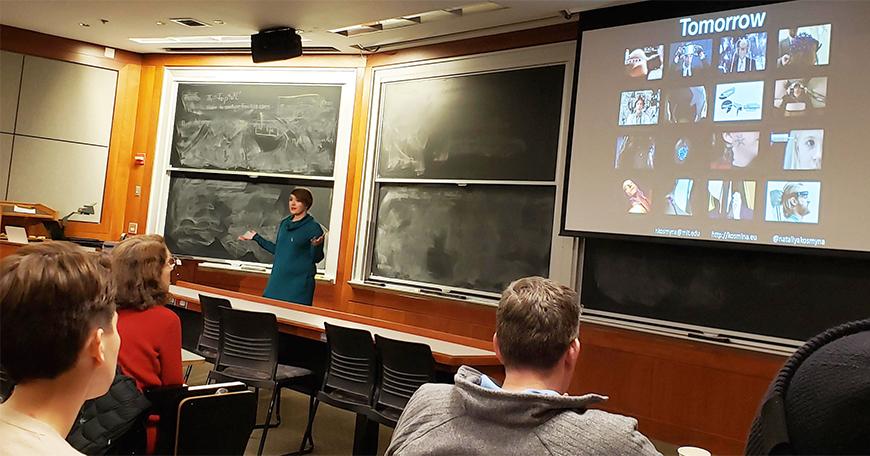
AttentivU Biosignals Help Re-focus Attention
Thanks to our constant connection to the Internet, getting access to information has never been easier. But this endless stream of content can pose issues for our ever-dwindling attention spans. Whether it’s focusing on work or listening to a lecture, there are multiple ways to get distracted: over the course of an hourlong lecture, our minds may often unintentionally wander, as we think about where we’ll go after the talk or what we’ll later eat for dinner. Dr. Nataliya Kosmyna, a postdoctoral associate at the MIT Media Lab, may have a solution to this problem: in her xTalk on February 13 she presented her work on AttentivU, a smart glasses prototype that aims to combat this widespread loss of attention.
AttentivU uses biosignals that can “read” and detect brain activity. It works through neurofeedback, vibrating when EEG sensors in the frame of the glasses detect a drop in attention. The glasses also have EOG sensors that detect eye movement and work along with the EEG sensors to monitor the wearer’s attention level, cognitive performance, and level of fatigue. The glasses also enable Bluetooth transmission to smartphones, and have bone conduction sound feedback on the frames which vibrate to let the wearer know when their attention is low. In addition to the glasses, there is a clip-on version that can be worn inside a shirt or jacket; it has the same function as the glasses and works by vibrating when low attention is detected.
AttentivU can be used for various scenarios: learning, driving, and focus. The most salient example of how AttentivU can be used for learning is for students in class who feel their attention waning, they can put on the glasses to help bring them back to attention. The glasses can also connect to smartphones and disable notifications when students are focused on sustained tasks such writing a paper. AttentivU glasses seem to be more effective when the body experiences vibrations in an unexpected area: for instance, the ears normally receive auditory feedback but not vibration, so when the AttentivU glasses frames vibrate near the ears, the wearer is more likely to pay attention than if the device vibrated near their hands. Besides helping to improve attention, such neural feedback can also possibly lessen the symptoms of ADHD.
Despite the many potential benefits of the AttentivU glasses, the various privacy and data protection issues that come along with such a device are worth considering. There is nothing preventing one’s physiological data from being used when gathered by the device, for example, and it is important to be aware of such issues linked to smart devices.
Dr. Kosmyna's xTalk audience posed challenging questions, such as "If the device senses a lapse in attention from a student, is it not the teacher, instead of the student, who is falling short of his/her task?" Additionally, the audience wondered about the possible dangers of eliminating mind wandering when in actually it might instead be beneficial to overall comprehension, given that the brain functions best with periodic periods of rest.
Nevertheless, the results of the AttentivU glasses show that such a device comes with many advantages, particularly as we continue to enter a digital world that is only becoming more and more intertwined with the Internet.
Learn more:
- Video of Dr Kosmyna's xTalk
- Dr Kosmyna's lecture slides
 Melissa Cao is an MIT senior majoring in management
Melissa Cao is an MIT senior majoring in management
About xTalks:
xTalks: Digital Discourses is a seminar series to facilitate awareness, deep understanding and transference of educational innovations at MIT and elsewhere. xTalks forums share strategies, solutions, and issues related to transformation in educational practice, particularly through the use of digital technologies.
Explore upcoming xTalks, as well as archives of past events with video, audio, and slides. To sign up for the xTalks mailing list, click here.

